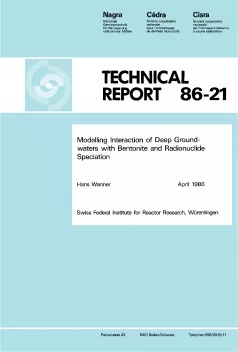
Technical Report NTB 86-21
Modelling Interaction of Deep Groundwaters with Bentonite and Radionuclide Speciation
In the safety analysis recently reported for a potential Swiss high-level waste repository, radionuclide speciation and solubility limits are calculated for expected granitic groundwater conditions. With the objective of deriving a more realistic description of radionuclide release from the near-field, an investigation has been initiated to quantitatively specify the chemistry of the near-field. In the Swiss case, the main components of the near-field are the glass waste matrix, a thick steel canister horizontally emplaced in a drift, and a backfill of highly compacted sodium bentonite.
This report describes a thermodynamic model which is used to estimate the chemical composition of the pore water in compacted sodium bentonite. Solubility limits and speciation of important actinides and the fission product technetium in the bentonite pore water are then calculated.
The model is based on available experimental data on the interaction of sodium bentonite and groundwater and represents means of extrapolation from laboratory data to repository conditions. The basic reactions between sodium bentonite and groundwater are described by an ion-exchange model for sodium, potassium, magnesium, and calcium. The model assumes equilibrium with calcite as long as sufficient carbonates remain in the bentonite, as well as quartz saturation. It is calculated that the pore water of compacted sodium bentonite saturated with Swiss Reference Groundwater will have a pH value of 9.7 and a free carbonate activity of 8 × 10-4 M. The long-term situation is modelled by the assumption that the near-field of a deep repository behaves like a mixing tank. In this way, an attempt is made to account for the continuous water exchange between the near-field and the host rock. It is found that sodium bentonite will be slowly converted to calcium bentonite. This conversion is roughly estimated to be completed after 2 million years. Illitisation of sodium bentonite is not taken into account.
The modelled composition of the pore water of compacted sodium bentonite, as well as the various compositions resulting from the long-term extrapolation, are used to estimate radionuclide solubilities in the near-field of a deep repository. The elements considered are: uranium, neptunium, plutonium, thorium, americium, and technetium. The redox potential in the near-field is assumed to be controlled by the corrosion products of the iron canister. Except for uranium and neptunium, radionuclide solubilities turn out to be lower under the modelled near-field conditions than in the groundwater of the surrounding granitic host rock. Uranium and neptunium solubitity might be higher by orders of magnitude in the near-field than in the far-field. This could lead to a comparatively strong downhill concentration gradient at the near-to-far-field boundary or within the buffer material. The possible extent of uranium and neptunium colloid formation in this area, and release into the far-field, is not discussed in detail but will strongly depend on the stability and mobility of such colloids.
From the chemical point of view, calcium bentonite seems to be more stable than sodium bentonite in the presence of Swiss Reference Groundwater. Since the effect of calcium bentonite on the groundwater chemical composition will be considerably less marked than that of sodium bentonite, especially with respect to key parameters. For the nuclide speciation like carbonate concentration and pH, the use of calcium bentonite instead of sodium bentonite will improve the reliability in the prediction of source terms for radionuclide transport in the geosphere.
